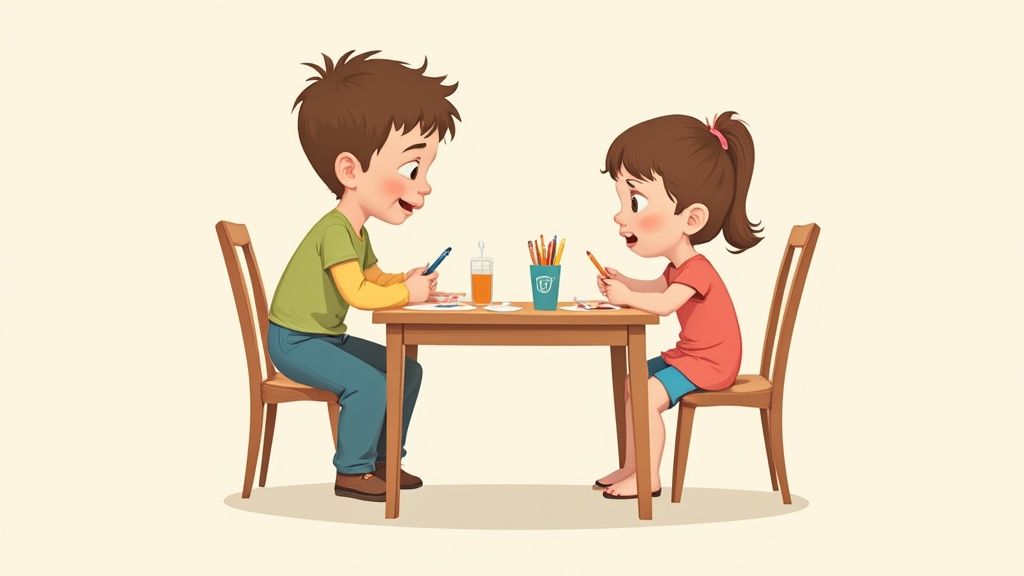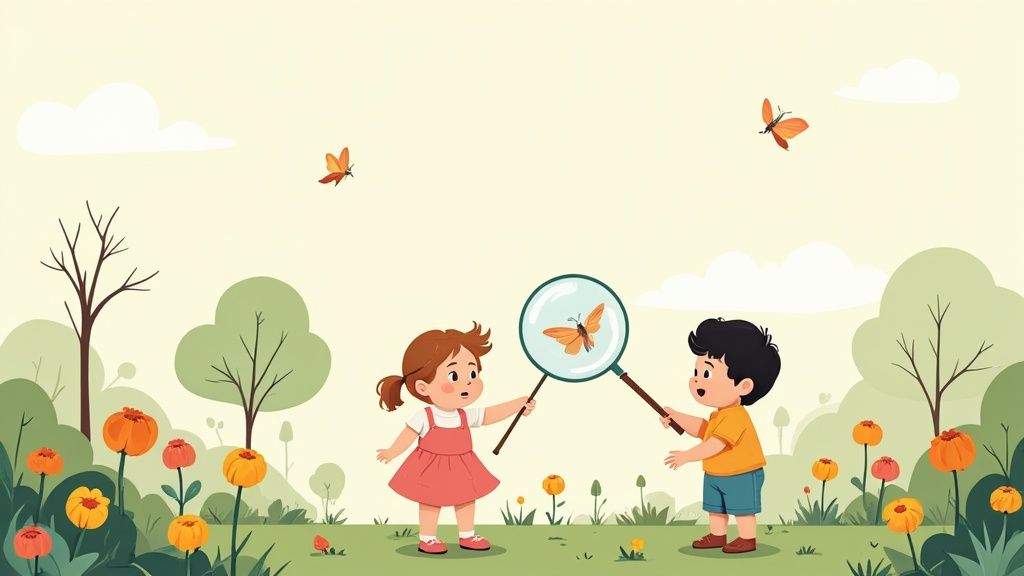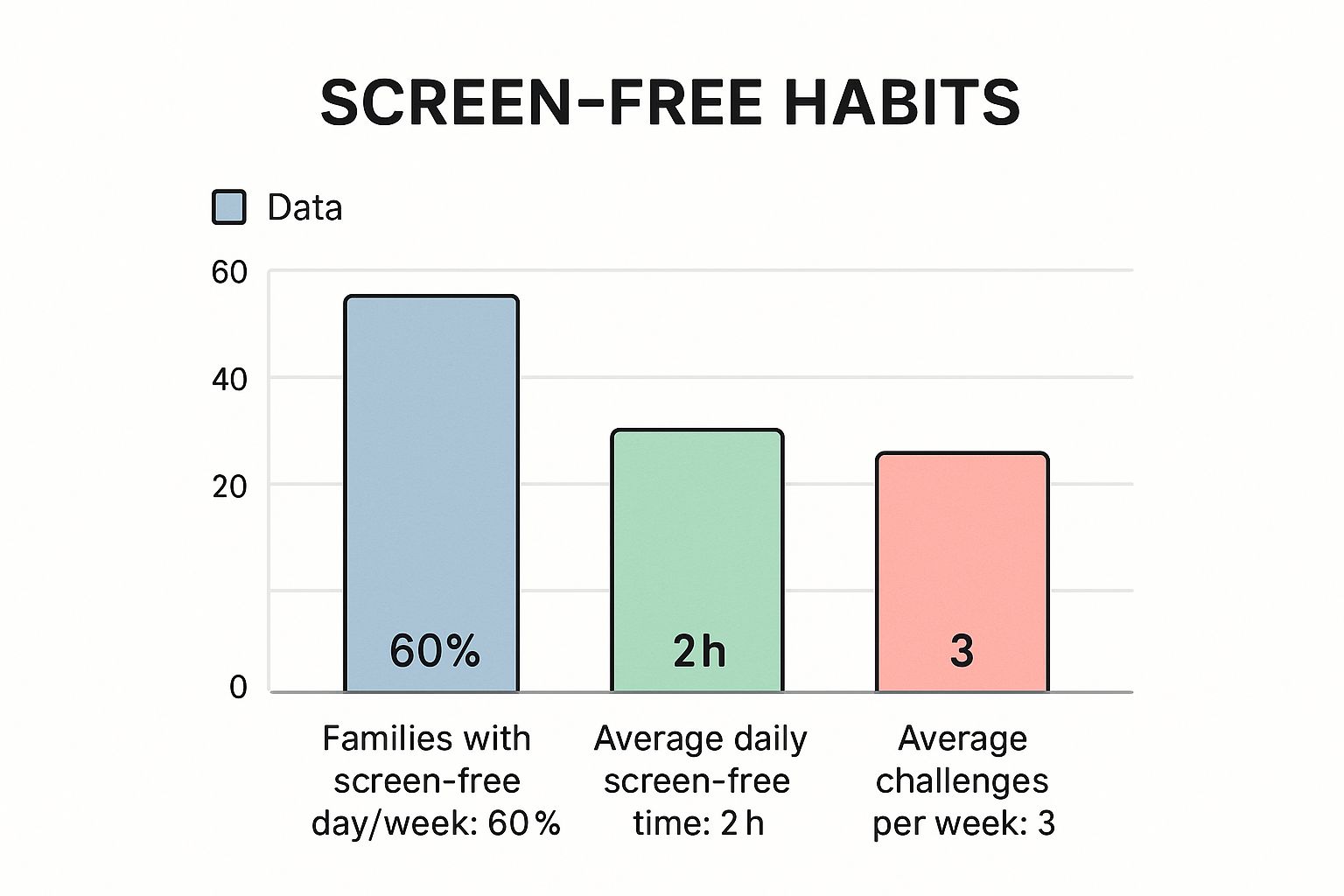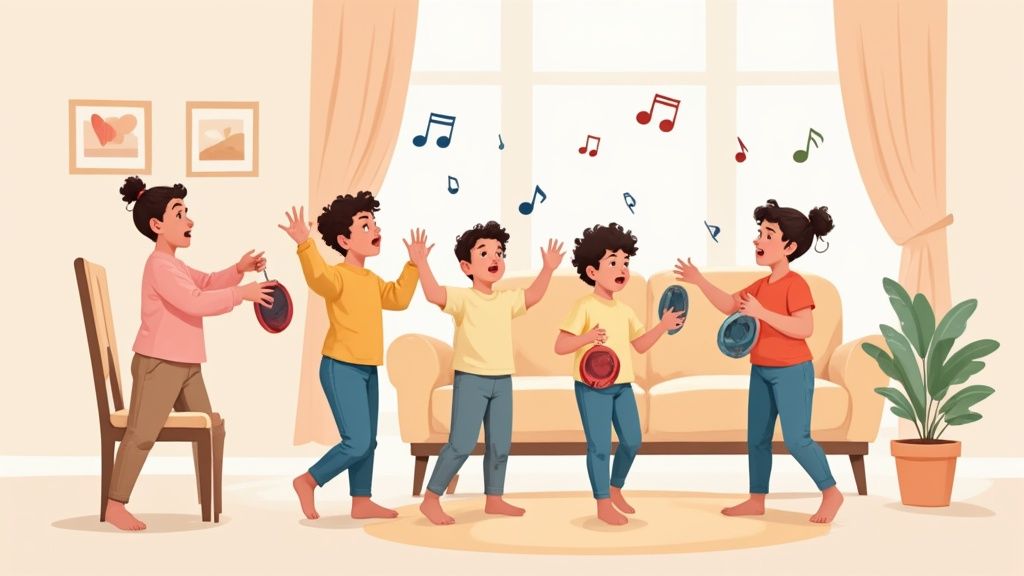One of the easiest, most effective ways I've found to keep kids entertained is by creating an 'activity toolkit.' Think of it as a go-to stash of basic supplies that can spark dozens of games and crafts at a moment's notice. This isn't about single-use toys; it’s about building a sustainable foundation for fun that encourages creativity and independence without you having to constantly direct the show.
Your Guide to Genuinely Happy and Engaged Kids

When you hear that all-too-familiar "I'm bored," it's tempting to feel like you need to pull a rabbit out of a hat. But the real secret to keeping kids happily occupied often lies in simplicity, not some grand spectacle. The goal isn't just to fill time—it's to ignite their natural curiosity and give them the tools to make their own fun. This guide is your new best friend for turning those restless moments into creative adventures.
Forget the complicated setups and expensive gadgets. We're going to focus on practical, low-prep ideas that work with a child's imagination. You don't need an entire craft store in your living room, just a thoughtfully curated collection of versatile items.
Assembling Your Activity Toolkit
An activity toolkit is your secret weapon against boredom. It’s simply a box, a bin, or maybe a rolling cart filled with open-ended materials that can be mixed and matched in endless ways. I like to think of it as a creative first-aid kit.
Here are a few essentials to get you started:
- Coloring Supplies: Don't just stop at basic crayons. A good kit includes washable markers, colored pencils, and maybe even a set of watercolor pencils for older kids. Actionable Tip: Keep a small pencil sharpener and an eraser in the kit so they don't have to ask for help every time a point breaks.
- Paper & Cardstock: Having a mix of plain white paper, colorful construction paper, and some sturdy cardstock gives kids a ton of options for drawing, cutting, and even 3D building. Practical Example: They can fold cardstock to make greeting cards or cut strips to build paper chains.
- Adhesives & Fasteners: You'll want kid-safe scissors, a few glue sticks, clear tape, and maybe some fun washi tape to bring their paper creations to life.
- Recycled Treasures: Never, ever underestimate the power of a cardboard tube, an empty egg carton, or a small box. To a kid, these are the raw materials for castles, robots, and spaceships.
The best entertainment tools are almost always the ones that don't have a single, defined purpose. A simple cardboard box offers infinitely more creative potential than a toy that only does one thing.
This toolkit becomes the launching pad for countless activities. The next time your child is looking for something to do, instead of handing them a specific toy, you can just point them toward their kit. It’s a small shift, but it encourages problem-solving and independence, teaching them how to answer the "I'm bored" question all by themselves.
Turn Coloring Into a Creative Adventure

Coloring is so much more than a simple way to pass the time. It’s a quiet powerhouse for development, building the fine motor skills kids need for writing and seriously boosting their ability to focus. But to really tap into that magic, we have to think beyond just handing them a coloring book and a box of crayons. It's surprisingly easy to transform this classic activity into a rich, creative experience.
The trick is to meet your child exactly where they are. What works for a toddler is worlds away from what will capture an eight-year-old’s imagination. For the little ones, it's all about exploring textures and learning how to hold a crayon.
First, Pick the Right Tools for the Job
Nothing shuts down creativity faster than frustration. Choosing age-appropriate supplies is the first and most important step to making coloring fun.
- For Toddlers (Ages 1-3): Go big and chunky! Think easy-grip, egg-shaped crayons or thick, triangular ones that won't roll off the table. They’re perfect for tiny hands just learning to grip.
- For Preschoolers (Ages 3-5): As their little hands get stronger, you can bring in fat-barreled washable markers and jumbo colored pencils. These give them more control and that satisfying pop of bright color they love.
- For Older Kids (Ages 6+): Now the real fun begins. Introduce them to watercolor pencils, fine-tip markers, or even sparkly gel pens. These tools open up a whole new world of detail, blending, and shading.
When you match the tools to their developmental stage, you’re setting them up for a win. It makes the entire process more rewarding, which builds their confidence and keeps them happily engaged.
Coloring isn't just about staying inside the lines. It’s about giving kids a low-stakes way to express themselves, make choices, and watch their own ideas come to life on the page.
Use Story Prompts and New Techniques to Spark Imagination
Once you have the perfect supplies, it's time to make that coloring page a launchpad for imagination. Don’t just give them a picture; give them a story to finish. This one small shift can turn a quiet activity into an interactive adventure.
Here are some practical coloring prompts:
- For a character page: "What superpower does this character have? Let's give them a costume with their superpower colors!"
- For a landscape: "Is this a hot sunny day or a cool, shady evening? How can you use colors to show the temperature?"
- For an animal: "Instead of brown, what if this was a rainbow dog? What color would its ears be?"
This simple technique gets them thinking in narratives and helps them connect with their art on a much deeper level. You can also tap into whatever they're currently obsessed with. If it's all about construction vehicles, find pages with excavators and cranes. A great place to start is with online coloring pages for kids, where you can find endless options to match any interest.
Themed coloring is another fantastic way to keep kids entertained, especially around holidays. For special occasions, you can find things like Mothers Day colouring pages that make the activity feel even more special and meaningful. When you make coloring an adventure, you're doing more than just filling time—you're nurturing a creative spirit.
Building Worlds with Everyday Imaginative Play
Imaginative play is where the real magic of childhood happens. It’s how kids figure out tricky social cues, learn to solve problems on their own, and make sense of their big feelings. And the best part? You don't need fancy, expensive toys to make it happen. The most incredible adventures usually start with the simplest things you have lying around the house.
The trick is learning to see the potential in everything. That cardboard box isn't just recycling—it's a spaceship cockpit waiting for paper plate controls, a race car that needs some crayon-drawn racing stripes, or a secret clubhouse that needs a password to get in. In the same way, a laundry basket can easily become a pirate ship sailing the high seas of your living room.
Setting the Stage for Their Adventures
Think of yourself as a stage manager, not the director. Instead of telling your kids what to play, just set up an "invitation to play" and let them create their own stories. This small shift gives them the reins, and honestly, it’s a huge confidence builder.
Here are a few actionable ideas to set up in minutes:
- Set up a Potion Lab: A few bowls, some spoons, and water with a drop of food coloring is all it takes. Actionable Tip: Add an ice cube tray for "magical ingredients" and a turkey baster for transferring liquids.
- Open an Animal Hospital: Round up all the stuffed animals and create a "doctor's kit" with some masking tape for bandages, a toy stethoscope, and a clipboard for taking very important notes.
- Start a "Restaurant": Grab some play food—or even just colorful pom-poms—and let them scribble a menu on a piece of paper. You get to be the customer placing all sorts of silly orders.
You might not realize it, but these simple setups are fantastic for developing dexterity. Carefully placing a "bandage" on a teddy bear or using tongs to serve "food" in their kitchen are amazing ways to practice hand-eye coordination. We dive deeper into this in our guide on how to improve fine motor skills.
When you empower children to lead their own stories, you're not just keeping them busy. You are helping them build the foundations of creativity, resilience, and self-assurance that will last a lifetime.
The Power of Just Letting Them Play
While structured activities have their place, the most significant growth happens when kids are free to explore without a rigid set of rules. It's interesting, though, because the demand for organized entertainment is skyrocketing. The global market for children’s entertainment centers was valued at USD 12.10 billion and is expected to more than double to USD 26.37 billion by 2034. It shows that parents are definitely looking for engaging experiences, which you can read more about over at ResearchAndMarkets.com.
But you can capture that same creative energy right at home, for free. By providing simple, open-ended props, you're giving your child the space to invent, experiment, and build entire worlds from scratch. So next time you go to toss a box, just pause and ask yourself—what could this be? The answer might just kick off an adventure that lasts the whole afternoon.
Fun Indoor Activities for Any Day and Any Mood
A rainy day, a sick day, or just a quiet afternoon—these are the perfect moments for some memorable indoor fun. Keeping kids entertained when you're stuck inside doesn't mean you need a closet bursting with brand-new toys. It’s really about having a playbook of simple, go-to ideas that you can pull out with minimal setup.
These activities are designed to be flexible, so you can easily adapt them to different ages, moods, and how much space you have. You'll always have the perfect fit for your day.
High-Energy Fun for Burning Off Steam
When the kids are literally bouncing off the walls, the best strategy is to lean into it. Instead of fighting that energy, give it a fun and constructive outlet.
An indoor obstacle course is a classic for a good reason. You can build a surprisingly engaging course with things you already have: pillows to hop over, blankets to crawl under, and a line of painter's tape on the floor to balance on. It feels like pure play, but they're also secretly working on balance and coordination.
Another fantastic choice is a scavenger hunt. For little ones, keep it simple with picture clues—a quick sketch of a shoe, a book, or a banana. For older kids, you can level up with riddles like, "I have a screen but no face, and I can take you to any place. What am I?" (Answer: a tablet or TV). This turns a simple search into a great brain-teaser.
Calming Activities for Quiet Moments
Then there are times when everyone needs to bring the energy level down a notch. This is where a sensory bin really shines. It's just a container filled with tactile materials that encourages focused, independent play.
Making one couldn't be easier:
- Pick a Base: Use household staples like dry rice, pasta, or even just water.
- Add Some Tools: Throw in scoops, funnels, and small cups for pouring and measuring.
- Give It a Theme: Toss in small plastic animals for a "dinosaur dig" in sand, or add a few drops of blue food coloring to water for a "deep sea adventure."
For those moments when you really need a peaceful interlude, finding some effective quiet time activities for preschoolers can be a game-changer for the whole family. These low-key options provide a much-needed reset.
The real secret to successful indoor fun isn't just filling time—it's about matching the activity to your child's mood and energy. A well-chosen activity can turn a potentially frustrating day into a genuinely fun and connected one.
Even with all these hands-on ideas, it's impossible to ignore the role technology plays in entertainment. The children's entertainment center market is booming, largely thanks to interactive tech. The arcade segment, which cleverly blends digital and physical games, holds over 27% of the market share. Kids aged 6 to 12 make up a whopping 57% of the visitors. This just goes to show how much kids crave dynamic, engaging fun.
To help you pick the perfect screen-free activity, here's a quick look at how other families are tackling it.

It's clear that more and more families are making a conscious effort to build non-digital playtime into their routines, recognizing just how valuable it is.
To make things even easier, I've put together a quick guide to help you choose the best indoor activity based on your child's energy level and how much supervision you can provide.
Indoor Activity Selector
| Activity Idea | Energy Level | Parental Involvement | Best for Ages |
|---|---|---|---|
| Pillow Obstacle Course | High | Medium (setup) | 3-8 |
| Picture Scavenger Hunt | Medium | High (setup & clues) | 2-5 |
| Riddle Scavenger Hunt | Medium | Medium (setup) | 6-10 |
| Rice Sensory Bin | Low | Low (after setup) | 2-6 |
| Water Sensory Bin | Low | Medium (supervision) | 2-6 |
Hopefully, this table gives you a quick-start guide for those moments when you need an idea, and you need it now
Making Fun a Family Affair: Building Bonds Through Play
Sure, independent play is important for kids, but there's a special kind of magic that happens when the whole family gets in on the fun. Turning a quiet afternoon into a group activity isn't just about killing time; it's about building real, lasting connections. These are the moments that strengthen communication, teach teamwork, and weave everyone closer together.
Think of yourself less as a director and more as a co-conspirator in fun. The best activities are the ones where everyone, from the littlest toddler to the grown-ups, can pitch in and feel like part of the team.
Jump into a Creative Project Together
One of the easiest ways to get everyone involved is with a simple, shared project. The key is to keep it low-pressure and focus on the fun of creating something together, rather than worrying about a perfect end result.
Here are a few actionable ideas to get the ball rolling:
- Host a Family Bake-Off: You don't need a complicated recipe. Just bake a batch of simple cupcakes and set up a decorating station. Lay out different colored frostings, sprinkles, and candies, and let everyone go wild. The messier and sillier, the better!
- Make a Giant Mural: Tape a big sheet of paper to the floor or a large table. Pick a simple theme like "Our Favorite Things" or "A Day at the Zoo," and let everyone draw, paint, or scribble their part of the picture.
- Put on a Goofy Play: Dig out some old costumes, hats, and props from the closet. You can brainstorm a simple story together and let everyone choose a character. The performance is guaranteed to be full of laughs and happy accidents.
When a family builds something together—whether it's a wonky birdhouse for the backyard or a simple LEGO city—they’re doing more than just passing the time. They’re building a stronger bond, one shared giggle at a time.
Bringing That Collaborative Spirit Home
It's no secret that families are craving more shared experiences. Just look at the family entertainment center industry, which is projected to explode from USD 34.4 billion in 2025 to a staggering USD 93.5 billion by 2035. You can see just how massive this trend is in this detailed market analysis from FutureMarketInsights.com.
The good news is you don't have to go out to capture that spirit. For those quieter moments, coloring side-by-side can be a wonderfully calming way to connect. We've put together a whole collection of free printable indoor activities for families with coloring pages and ideas perfect for all ages.
By working on something together, even something as simple as a coloring page, you're actively stocking up your family's treasure chest of happy memories.
Common Questions About Entertaining Kids

Even with an arsenal of ideas, you’re bound to have questions. Let’s be honest, figuring out how to keep kids happily occupied day in and day out can be a real challenge. Here are some of the questions I hear most often, along with some practical advice that actually works.
How Can I Entertain My Child Without Screens?
Getting away from screens is all about having a few engaging, hands-on alternatives ready before the boredom sets in. You don’t need a Pinterest-perfect setup, just a few simple, go-to options.
One of my favorites is the "invention box." Just grab an old shoebox and fill it with safe odds and ends from the recycling bin—cardboard tubes, plastic lids, string, and tape. It’s an open invitation for them to build, create, and solve problems on their own terms. And you can never go wrong with a classic blanket fort.
Sensory bins are another lifesaver. Fill a small plastic tub with dried pasta, colored rice, or just water and a few bath toys. This kind of tactile play can keep little ones focused and engaged for a surprisingly long time. Keeping a small, rotating selection of puzzles and books in plain sight also makes it easier for them to grab something other than a tablet.
What Are the Best Low-Cost Ideas to Keep Kids Busy?
You don't need to spend a lot of money to have a great time. In fact, some of the most memorable activities are totally free or use things you already have lying around the house.
A simple nature walk is a great example. It gets everyone outside and lets kids collect treasures like interesting leaves, smooth rocks, or cool-looking sticks that can be used for an art project later. You can also make amazing creations using just the materials from that invention box I mentioned.
And don't forget about your local library! It’s an absolute goldmine for free entertainment. Beyond the endless supply of books, many libraries offer story times, craft sessions, and other kids' programs that give you a change of scenery and a chance for your child to interact with others.
Printable coloring pages are another fantastic, low-cost option. They provide a steady stream of new content that you can match to whatever your child is obsessed with this week, making them a parent's best friend for a quick, quiet activity.
How Do I Encourage Independent Play?
Getting your child to play on their own is a skill that takes time and patience to build. You can't just flip a switch and expect them to suddenly entertain themselves for an hour. It's a gradual process.
Start by setting up an activity that’s inviting but simple, like a new coloring page or a straightforward puzzle. Spend the first few minutes engaged with them, then let them know you need to go fold some laundry or start dinner right nearby, and you'll be back to see what they've done.
Over time, you can slowly stretch out the amount of time you're away. It also helps to have a dedicated "yes space" where their favorite toys and art supplies are organized and easy for them to reach. This gives them the power to start their own fun without needing you to set everything up.
Most importantly, always praise their effort, even if they only played alone for five minutes. A little positive reinforcement goes a long way in building their confidence and making them proud of their independence.
Ready to turn "I'm bored" into a creative adventure? Colortada offers hundreds of free, printable coloring pages featuring your child's favorite characters. From Bluey to Disney, find the perfect activity to spark their imagination and give you a moment of peace. Download your free pages today at https://www.colortada.com.

